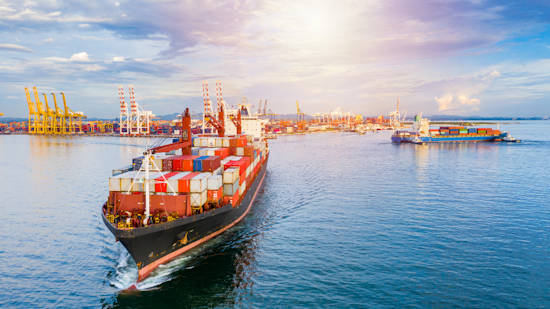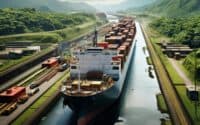Cutting Costs and Waves: How Ship Owners Can Save Big on Fuel

In recent years, the maritime industry has seen a significant surge in fuel prices, casting ripples throughout global shipping operations. This surge is not merely a fluctuating market anomaly; it’s a trend that’s been steadily ascending, influenced by geopolitical events, global production capacities, and a myriad of other interconnected factors. Such an upswing has implications far beyond balance sheets: it dictates routing decisions, speed strategies, and, on a broader scale, the financial viability of certain shipping routes.
* Please send feedback/suggestions to editor @ shipuniverse.com
However, the implications of fuel consumption aren’t solely monetary. The environmental footprint of the maritime sector is vast. Ships, while being one of the most efficient means of transport, emit greenhouse gases and other pollutants, with significant repercussions for our planet’s climate and marine ecosystems. Optimizing fuel consumption can dramatically reduce these emissions, aligning the shipping industry more closely with global environmental goals.
Moreover, from an economic standpoint, efficient fuel use means streamlined operations, reduced overheads, and enhanced competitiveness in an industry where margins often hang in the balance. For ship owners, the dual goals of economic sustainability and environmental responsibility converge at the nexus of fuel optimization.
In the subsequent sections, we’ll dive deeper into the science of fuel consumption, explore the design elements of ships that influence it, and, most importantly, highlight strategies that can assist ship owners in maximizing their fuel efficiency.
Understanding the Fundamentals of Fuel Consumption
The Science Behind Fuel Efficiency
Every ship, regardless of size or purpose, relies on a fundamental principle: converting fuel into energy. This energy is what powers the ship’s engine, propelling it forward. At the heart of this conversion is the combustion process, where fuel reacts with oxygen to release energy. However, not all the energy from this reaction is harnessed efficiently. Factors such as engine design, fuel quality, and combustion conditions can influence how much energy is extracted from every gallon of fuel.
Beyond the engine’s internal dynamics, several external factors can also impact fuel consumption rates on ships. Ocean currents, wind resistance, and even the weight of the cargo can play significant roles in determining how much fuel a ship consumes on a voyage.
The Role of Ship Design and Equipment
The very design of a ship can significantly influence its fuel efficiency. For instance, the shape of a ship’s hull determines how it interacts with water. A well-designed hull can minimize hydrodynamic drag, ensuring that the ship moves through water with the least resistance. Regular maintenance, like hull cleaning, can also play a crucial role, as marine growth or fouling can increase drag.
Then there’s the matter of a ship’s propeller. Just as the hull interacts with water, the propeller’s design and condition can either enhance or hinder a ship’s performance. A propeller that’s designed for optimal hydrodynamic efficiency can drastically reduce fuel consumption. Moreover, other onboard equipment, from pumps to generators, can also influence overall fuel efficiency. Proper maintenance and timely upgrades of this equipment can lead to tangible savings.
Best Practices for Optimizing Fuel Use
Speed Optimization and the Benefits of Slow Steaming One of the most immediate ways to influence fuel consumption is by controlling a ship’s speed. The relationship between speed and fuel consumption is not linear; a slight increase in speed can lead to a significant rise in fuel consumption. This understanding has given rise to the practice of “slow steaming.” By operating at reduced speeds, ships can dramatically decrease their fuel use. Additionally, slow steaming reduces engine strain, potentially increasing the lifespan of onboard machinery. However, operators need to balance the advantages of slow steaming with the need to meet schedules and satisfy customer expectations.
Effective Voyage Planning for Optimal Routes and Currents Efficient voyage planning is more than just plotting a course from Point A to Point B. It’s about anticipating and leveraging oceanic and atmospheric conditions. By understanding and utilizing currents, a ship can “ride” these natural water flows, conserving fuel. Similarly, avoiding adverse weather conditions like storms can prevent unnecessary fuel burn. Modern navigation software, which integrates real-time weather and oceanic data, can assist navigators in plotting the most efficient and safe routes.
Maintenance Matters
Regular Engine Check-Ups and Timely Overhauls An engine operating below its optimal efficiency can become a significant fuel guzzler. Regular check-ups can help identify issues like faulty injectors or compromised combustion processes that might be affecting performance. Preventative maintenance, such as timely overhauls, can restore the engine to its peak condition, ensuring that every drop of fuel is utilized effectively. Moreover, consistent engine monitoring can provide early warnings of potential problems, allowing for proactive interventions.
Hull Cleaning and Antifouling Coatings to Minimize Resistance A ship’s hull is in constant contact with water, making it susceptible to biofouling, where marine organisms like barnacles and algae adhere to the surface. This biological growth increases surface roughness, enhancing hydrodynamic drag and consequently fuel consumption. Regular hull cleaning procedures can remove these organisms, ensuring a smoother, more efficient voyage. Additionally, the application of antifouling coatings can prevent or reduce the rate of biological colonization, offering a proactive solution to the challenge of hull fouling.
Embracing Modern Technologies for Enhanced Fuel Savings
Fuel Monitoring Systems for Real-time Analysis In the age of information, real-time data has become a cornerstone of operational efficiency. Fuel monitoring systems, utilizing an array of sensors and data analytics platforms, offer ship operators instant feedback on their vessel’s fuel consumption. These systems can pinpoint inefficiencies, whether it’s an underperforming engine or suboptimal navigation. More than just a diagnostic tool, real-time fuel monitoring allows for dynamic adjustments, helping crews adapt to changing conditions and ensuring optimal fuel usage throughout a voyage.
Advanced Navigation Tools for Route Optimization Navigation has undergone a digital revolution. Gone are the days when navigators solely relied on charts and intuition. Today’s advanced navigation systems, harnessing the power of satellite technology, artificial intelligence, and vast meteorological databases, can predict the most fuel-efficient routes. They consider a multitude of factors, from sea currents and wind patterns to traffic and port schedules. By constantly updating the ship’s course in response to these changing variables, these tools can lead to significant fuel savings and safer voyages.
Alternative Propulsion Methods
The Potential of Wind and Solar-assisted Propulsion Harnessing the power of nature isn’t a new concept for sailors, but modern technology has reinvigorated the potential of wind and solar energy. Wind-assisted propulsion, using kites or modernized sails, can either supplement or, in some cases, replace conventional propulsion methods. While not suitable for all vessel types or routes, they offer an eco-friendly and economical alternative. Solar panels, on the other hand, can be integrated into a ship’s infrastructure. While they might not power the main propulsion systems, they can cater to onboard energy needs, reducing the overall load on traditional engines and contributing to fuel savings.
Hybrid and Electric Propulsion Systems The success of hybrid and electric technologies in automotive industries has spurred interest in their maritime applications. Hybrid propulsion systems combine conventional engines with electric motors and battery storage. This allows ships to operate solely on electric power in certain conditions, like when near coastlines or in ports, reducing emissions and fuel consumption. Fully electric ships, while still in their nascent stages, hold promise for short-distance routes, offering a clean, quiet, and efficient mode of transport. As battery technology continues to evolve, the feasibility and range of electric vessels are bound to increase, marking a transformative shift in maritime propulsion.
In Summary
In the ever-evolving landscape of the maritime industry, the pursuit of fuel efficiency is not just a cost-saving endeavor—it’s a commitment to environmental stewardship and long-term sustainability. As we’ve explored, the strategies to optimize fuel consumption range from tried-and-true operational adjustments to the pioneering use of modern technologies. By marrying traditional knowledge with innovative solutions, ship owners can navigate the dual challenges of economic pressures and environmental concerns.
The wave of digital transformation and alternative propulsion methods underscore a bright future for the industry. These advancements not only promise significant fuel savings but also chart a course towards a more sustainable and responsible maritime sector. As global dynamics continue to shift, it’s incumbent upon ship owners and operators to remain proactive, embracing the tools and practices that ensure both the viability of their operations and the health of our planet’s oceans.
In the journey across the vast expanse of the seas, it’s clear that the most efficient path forward is one of continuous learning, adaptation, and innovation.

Do you have a Maritime Product or Service that may be of interest to Shipowners? Tell us about it here!
Do you have feedback or insights? Please reach out to editor @ shipuniverse.com



